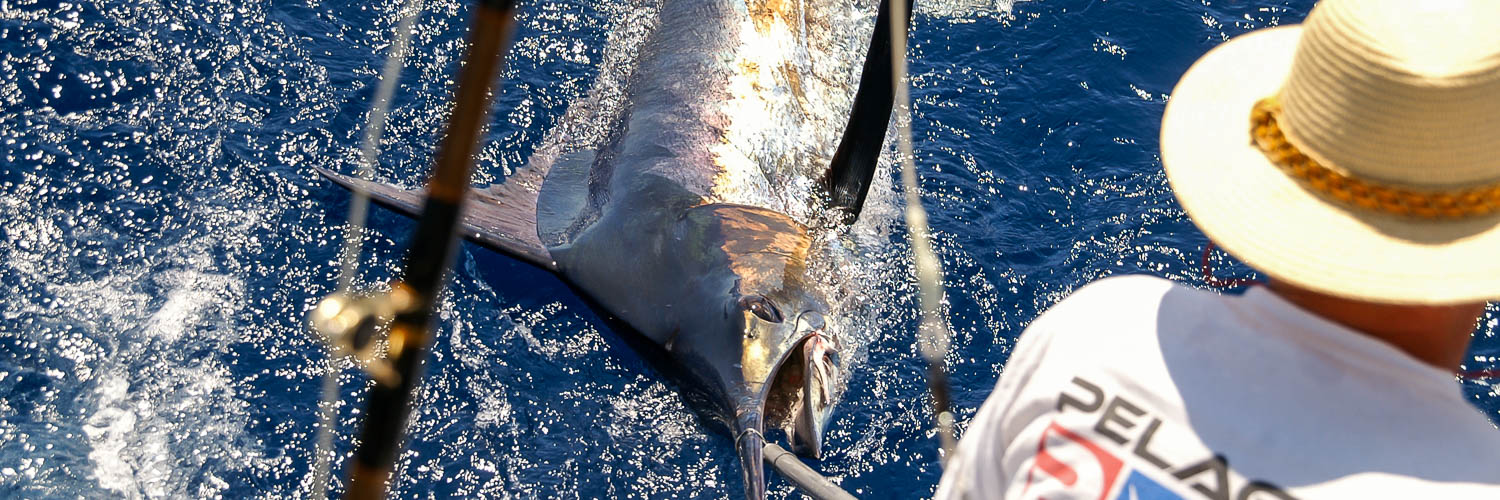

Blue Marlin are often considered fishings’ greatest challenge and thrill amongst sport and big game fishing communities. Distributed throughout the tropical and subtropical waters of the Atlantic Ocean, they’re a true bluewater species that spend the majority of their life in the open ocean, mainly near the surface of the water, far away from land; they are also highly migratory.
The Marlin are one of the largest species of bony fishes, beginning as microscopic larvae and reaching lengths of more than 16ft and weights of over 1000lb. The largest ever caught by IGFA angling rules is a fish that weighed 1,402lb. Fish of over 1,000lb are often referred to by big game anglers as ‘Granders’, and females can grow up to four times the weight of males.
The Blue Marlin are one of the fastest and hard fighting fish in the ocean, renowned for their scintillating bursts of speed and acrobatic fighting style; they can test tackle and anglers to their limits and battles lasting many hours aren’t uncommon. They’re aggressive predators and feed on Mackerel, Tuna and Squid, using their bills to slash through dense schools of baitfish, stunning and injuring their prey before returning to eat their wounded victims. Anglers targeting them use a range of different fishing methods; however, the most popular and effective is trolling artificial lures, typically five to seven baits in a ‘pattern’ to imitate a school of baitfish.
Below are the top destinations in the world for Blue Marlin Fishing.
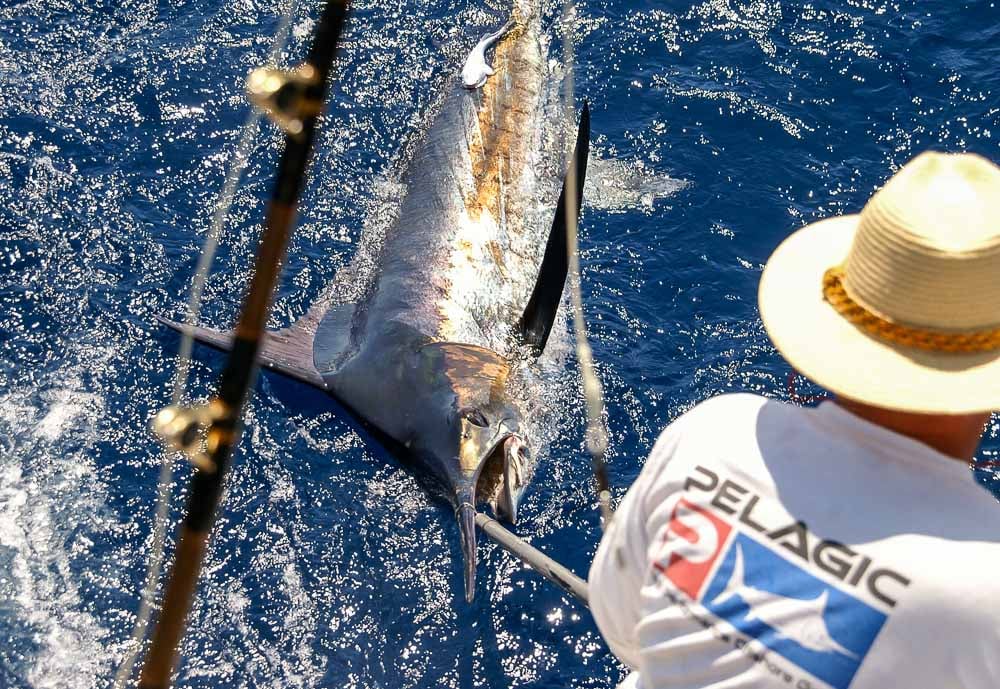

Madeira for many years has produced some of the worlds biggest Blue Marlin and back in 1995, 1996 and 1997 Madeira was the world cup winner. So, if you are a true specimen hunter, we can’t think of a better place to head to for a fish of a lifetime. Perfect for a family getaway with it only being a couple of hour’s flight.


Due to the amazing fishing at Rodrigues Island, Sportquest Holidays decided to put on their very own hosted Jig fishing trip to the fish packed waters that surround Rodrigues Island in Mauritius. This trip is for the anglers out there who seek adventure and excitement with some pretty extreme fishing for fish that absolutely pull your arms off.
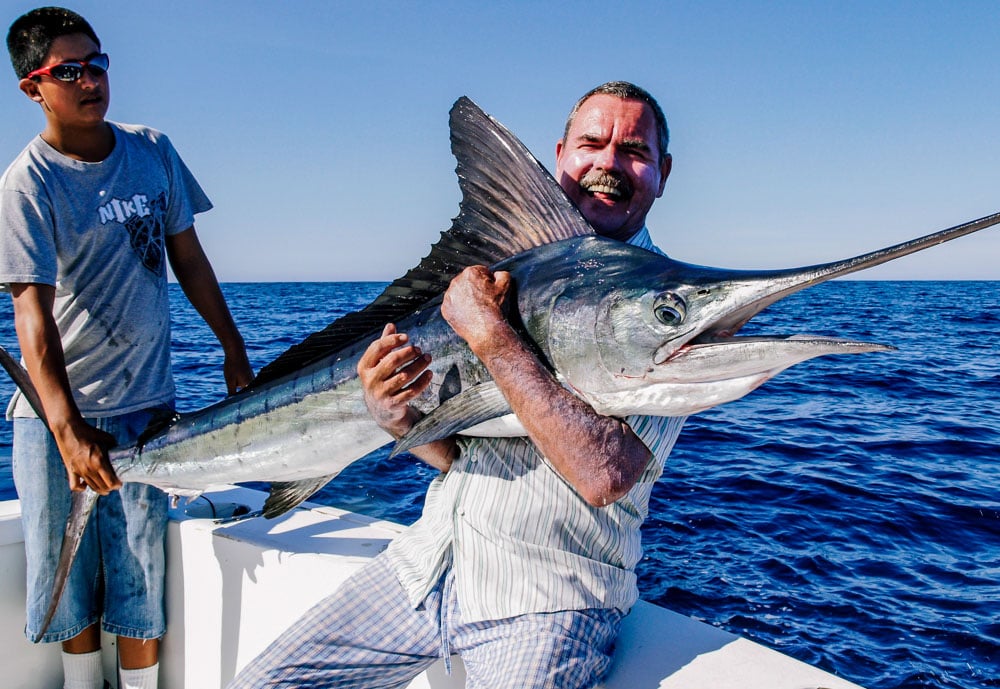

Palma de Cortez resort in Mexico is the ideal big game fishing destination. Not only is the resort located next to all the prime fishing grounds but all tackle is included too. On top of this, we now offer light tackle packages on all Panga boats for bait fishing which include all hooks, weights and leaders free for you to use.


La Gomera is the ideal big game fishing destination for anyone who does not like long flights. It is also perfect for a family fishing holiday as the island is packed with other attractions to keep the entire family entertained. You will be fishing some of Europe’s most prolific waters for species such as Blue Marlin and massive Giant Bluefin Tuna.


Bluewater Fishing Panama offers travelling anglers the chance to enjoy a fantastic week of mixed fishing for an array of hard-fighting species. Fishing the rich waters of the Gulf of Chiriquí, an area responsible for over 50 IGFA World Records, you'll wet a line in some of the most famous fishing marks on the planet.
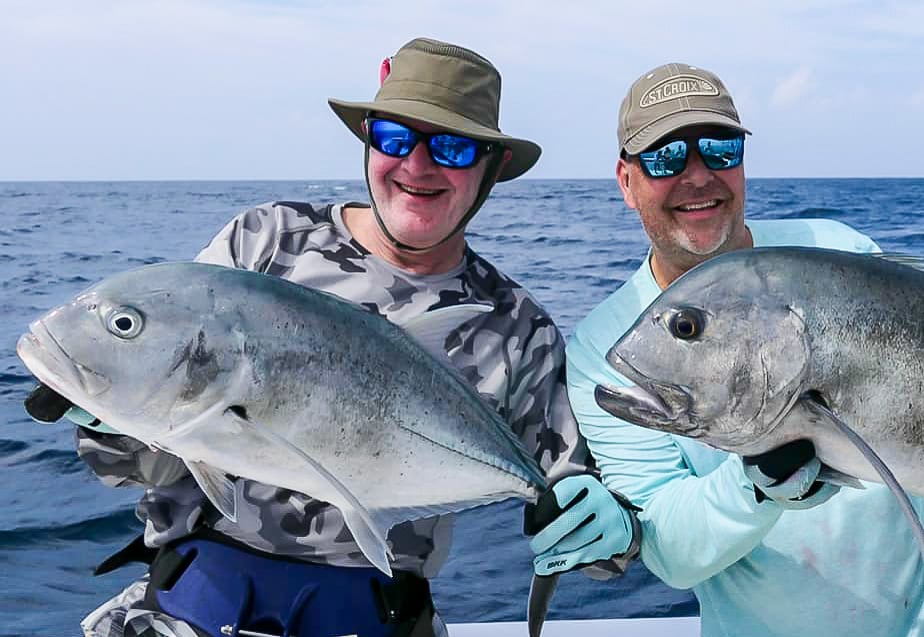

The Maldives Liveaboard trip allows travelling rods to experience some of the most exciting and explosive bluewater fishing in the world, casting poppers and jigs to some of the most remote areas of the Laamu Atoll. Situated in the rich waters of the Indian Ocean, it's home to over 1,100 fish species, from small reef dwellers to giant pelagics.


This fishing adventure is like no others out there! Rodrigues Island in Mauritius offers anglers a unique opportunity to fish for some of the worlds most incredible species. The fishing style used is completely down to you and we can tailor the itinerary to suit how you wish to fish and the species you wish to target.


The Zancudo Lodge, where over 70 IGFA records have been set, is world-renowned for its lure and fly fishing inshore and offshore and its finest service. You will receive access to all the required fishing tackle from ultra-light to heavy fly fishing tackle with all poppers, lures, jigs and small flies will also be included.
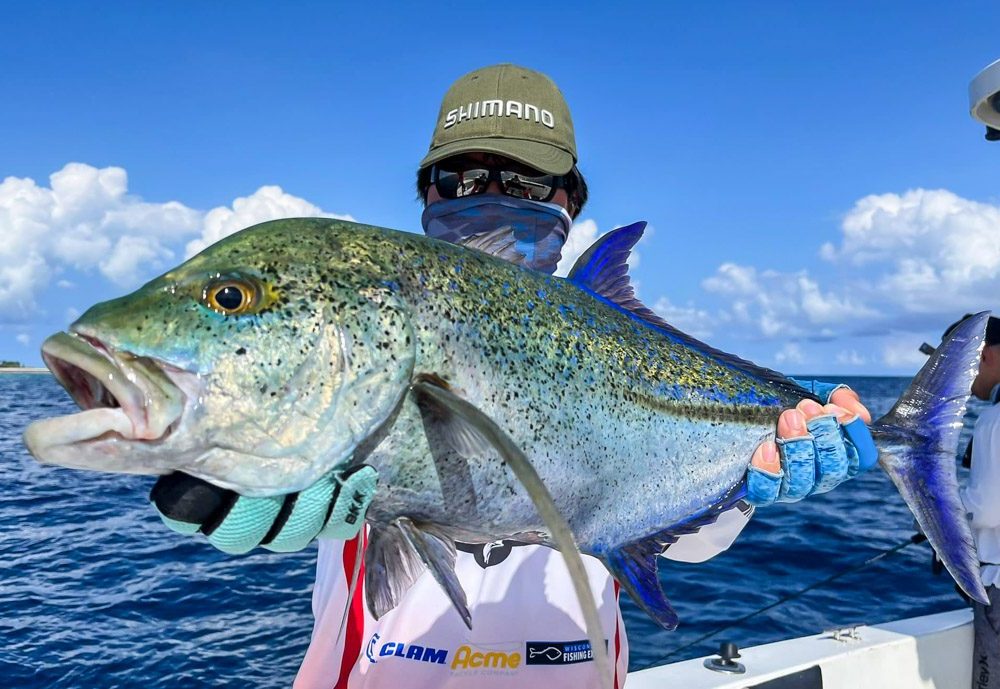

The Maldives is one of the top five names that appear on anglers' bucket lists worldwide. Home to over 1,100 fish species, from small reef dwellers to giant pelagics, it offers travelling rods the opportunity to enjoy some of the finest bluewater popper and jig fishing found anywhere on the planet.


Every sport fisherman has heard of stories of how world-class the fishery is in Panama and it's no wondering when Panama is the home to so many IGFA records of all manner of species and our lodge is right in the thick of it. The Gulf of Chiriquí is a real treasure of Panama and with the likes of world-renowned areas such as Hannibal Bank and Isla Montuosa being the fishing grounds


Astove Atoll gives six lucky anglers each week the exclusivity of one of the wildest, most rugged atolls on the globe for a wide range of saltwater flats species. This is a wild, secluded and remarkably remote small-scale destination for anglers seeking adventure and a unique fishing experience not to be missed.


The world-class resort in Costa Rica called Crocodile Bay has won so many awards on Trip Adviser that we class it as a must go for any big game angler. It is also the perfect destination to take your non-angling family, as the eco tours onsite are unbelievable and if you were to stay there for a whole month, you would never get through them.


El Bahia de Los Suenos, also commonly referred to as the ‘Bay of Dreams’, offers travelling rods mile upon mile of open and accessible coastline, as well as some of the richest offshore waters found anywhere in the world. Here, the Roosterfish is king, and the area is probably the number one destination for both numbers and the large average size of fish.
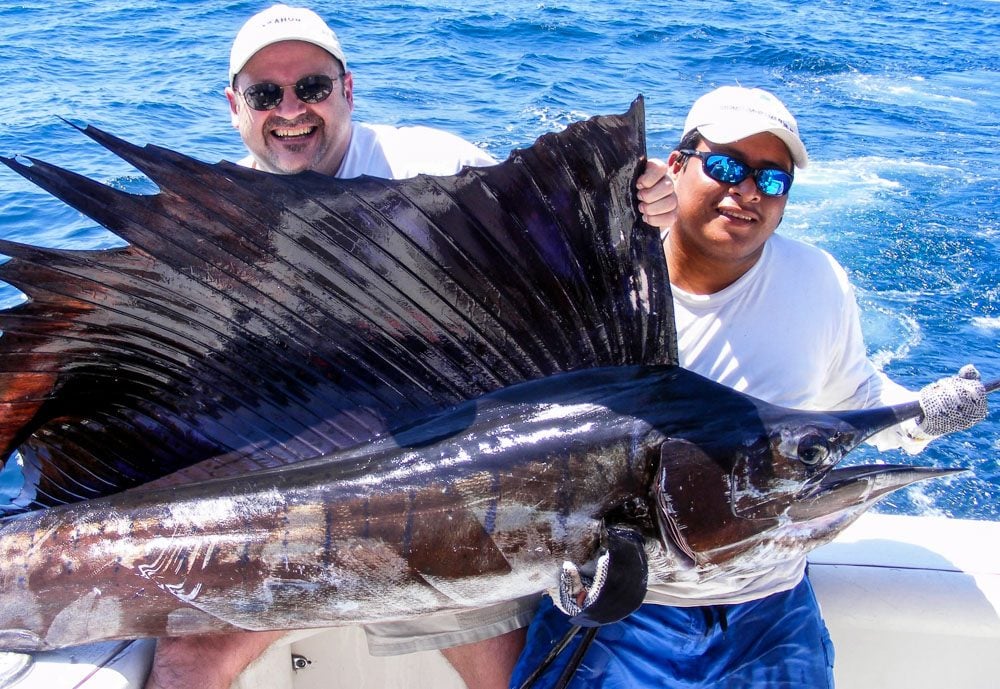

Guatemala is the most prolific and talked about Sailfish destination in the world. Home to so many world records it really is classed as the number one place in the world. Our boats get really good numbers of fish during peak times and you will soon find your self realising that this part of the world is a must visit Sailfish destination.


Average Customer Satisfaction Score 97%
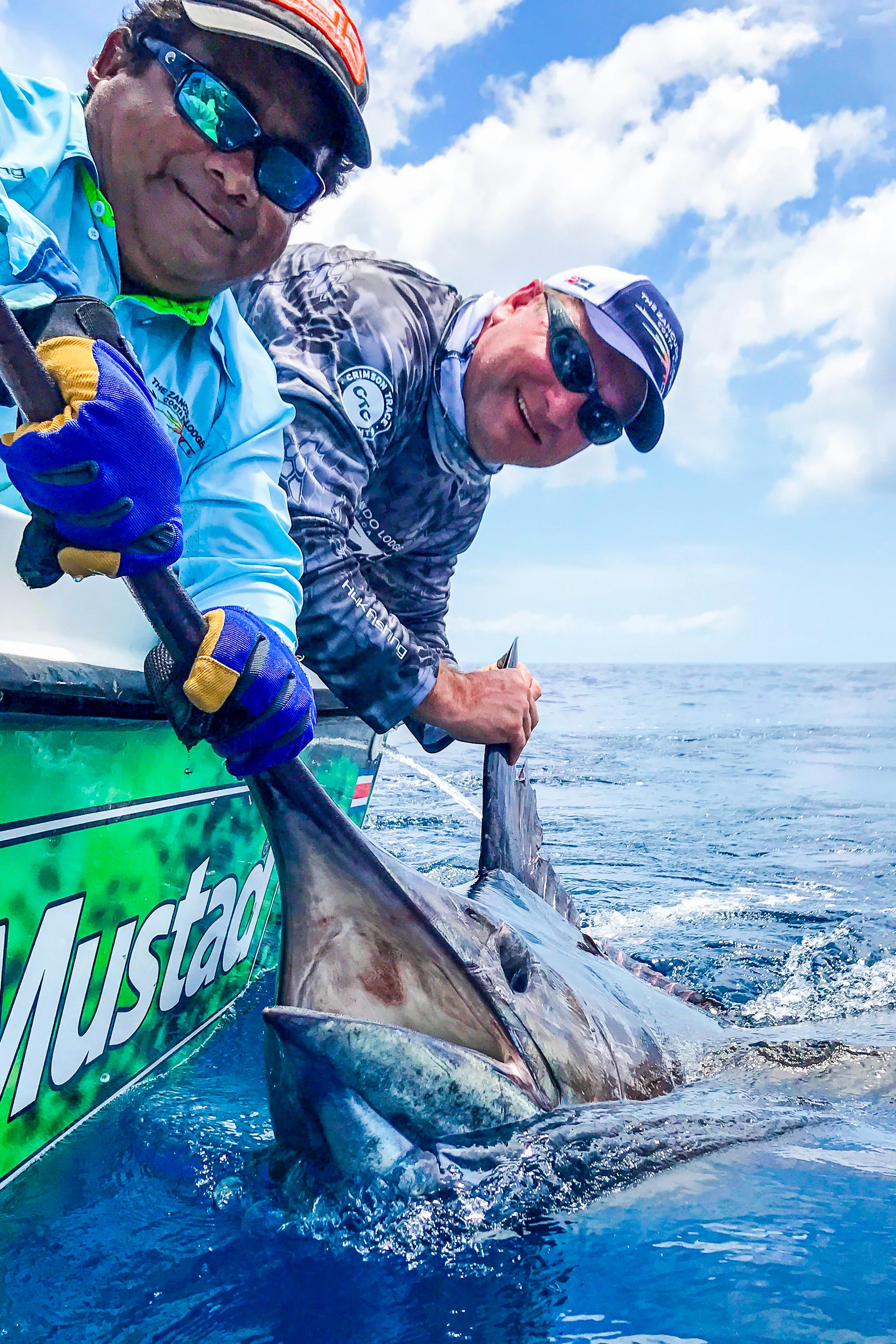

Name: Blue Marlin
Also known as: Atlantic Blue Marlin, Billfish
Scientific name: Makaira Nigricans
Blue Marlin are among the most recognisable fish species. They feature a brilliant blue-black colouration on top, a silvery-white underside, and striking cobalt-coloured stripes on both sides of their bodies. They have two dorsal fins and two anal fins, which along with their pectoral and caudal fins, can be folded into grooves in their body, helping to streamline them and thereby reduce drag when swimming in the water.
Their most distinctive and recognisable feature is their bill, which is long and stout and filled with small file-like teeth. They use this bill to spear and slash their way through dense shoals of bait fish, returning to eat their stunned and wounded victims. They are among the fastest fish in the ocean and are known for putting up an incredible battle when hooked. For many travelling rods around the globe, they are considered the ‘Holy Grail’ of sport fish.
Blue Marlin reach maturity between two and four years old and spawn in late summer and autumn; it’s not unusual for them to spawn up to four times a season, releasing up to seven million eggs each time. The females are always the largest and can weigh up to four times that of males, which rarely exceed 350lb. They also live longer, up to 27 years, compared to 18 years for males.
Fact: Blue marlin, like other billfish, can rapidly change colour, an effect created by pigment-containing iridophores and light-reflecting skin cells
Blue Marlin are found year-round in the tropical waters of the Atlantic and Indo-Pacific Oceans, but their range expands into the temperate waters of the Northern and Southern Hemispheres during the warmer months and contracts towards the Equator during colder months. Warm currents such as the Gulf Stream in the western Atlantic significantly influence their seasonal distribution, and they have been known to follow these currents for hundreds and even thousands of miles. Most notably, a fish tagged off the coast of Delaware was recovered near the island of Mauritius off the southeast coast of Africa in the Indian Ocean – a voyage of 9,254 miles.
Anglers wishing to target and catch a Blue Marlin have abundant and varied opportunities worldwide. For rods travelling from the UK, Madeira is the closest destination, throwing up some of the largest fish in the world. It’s popular, especially amongst specimen hunters who dream of landing that Marlin of a lifetime, a ‘Grander’, a Blue Marlin that exceeds 1000lb. Travelling further afield, the likes of Costa Rica, Panama and Mexico in the Pacific offer some fantastic big game and bluewater fishing, not just for Marlin but a whole array of species. While the islands of Rodrigues, Seychelles and Maldives are some of the best areas in the Indian Ocean.
Our top five Blue Marlin fishing tours:
Blue Marlin Fishing Madeira
Crocodile Bay Costa Rica
Bluewater Fishing Panama
Palmas De Cortez Mexico
Rodrigues Island Mauritius
Globally, the most effective method for catching Blue Marlin is, without a doubt, trolling artificial lures or dead baits, usually five to seven baits in a formation behind the back of the boat. The optimal speed for trolling is around 8-10 knots, but this can vary depending on the baits used and sea conditions. With Marlin preferring to feed on Mackerel and Tuna in the warmer upper layers of water, much of the trolling gets done on the surface; however, they will also dive deeper to hunt squid and other baitfish, so it’s always worth varying the depths baits get trolled at.
When trolling, the rod furthest behind the boat – usually around 150ft back – typically comes from the rod in the centre of the wheelhouse, above the fighting chair. The following two-rod sets will be the furthest left and right; these are usually positioned on the tip of the outriggers and trolled not quite as far back as the centre-high rod. The following two rods will be positioned in the middle of the left and right-hand gunnels and rigged halfway along with the outriggers. These will be the closest lures/baits to the boat. Sometimes, there will also be a couple of lighter rods positioned in the boat, but not ‘live’. These will just be ready if the chance comes to switch and tease the fish. It may sound complicated, but it’s a straightforward process when you all work together on the boat.
Although trolling is the most popular and effective method, in certain parts of the world, like Rodrigues Island in Mauritius and the Andaman Islands, many Blue Marlin get caught each season on Jigs.
If you’ve never been big game fishing or trolling before and would like to learn more about it, you can read our blog: Is Big Game Trolling Right For Me?
Blue Marlin are some of the biggest fish in the ocean and can top 1,000lb in weight. Specimens of this size are known as ‘Granders’, and landing a fish of this size is considered by many to be one of the outstanding achievements of angling. However, as a rough guide, the average size for a Blue Marlin is between 200 and 400 pounds. Female Blue Marlin are always the largest and can weigh up to four times that of males, which rarely exceed 350lb.
The biggest Blue Marlin ever caught by IGFA rules was landed from Vitoria in Brazil and weighed in at a colossal 1,402lb.
To learn more about Blue Marlin, visit our YouTube channel.











